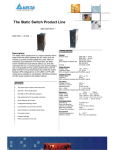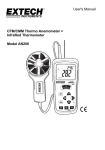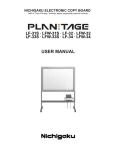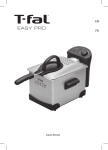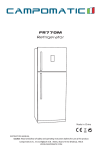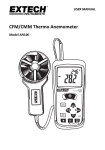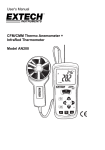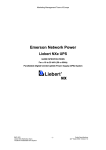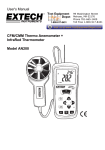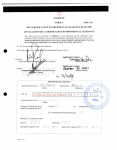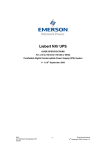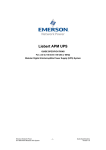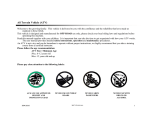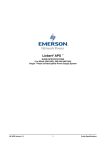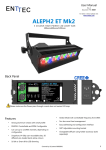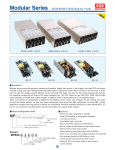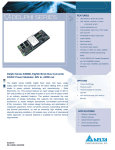Download Liebert NXC UPS - Emerson Network Power
Transcript
Liebert NXC UPS GUIDE SPECIFICATIONS For a 10 to 20 kVA (50 or 60Hz) Parallelable Digital Uninterruptible Power Supply (UPS) System V-1 ENP 10-20kVA Parallelable UPS System -1- Guide Specifications Version-1.0 Contents 1.1 SUMMARY .................................................................................................................................. 3 1.2 STANDARDS .............................................................................................................................. 3 1.3 SYSTEM DESCRIPTION ............................................................................................................ 4 1.3.1 Design Requirements ....................................................................................................................... 4 1.3.2 Modes of Operation ......................................................................................................................... 4 1.3.3 Performance Requirements .............................................................................................................. 6 1.3.3.1 UPS Module AC Input .......................................................................................................... 6 1.3.3.2 UPS Module AC Output ....................................................................................................... 6 1.3.3.3 Bypass Static Switch ............................................................................................................. 7 1.3.3.4 Earthing................................................................................................................................. 7 1.4 ENVIRONMENTAL CONDITIONS .............................................................................................. 8 1.4.1 Operating Ambient Temperature ..................................................................................................... 8 1.4.2 Storage/Transport Ambient Temperature ........................................................................................ 8 1.4.3 Relative Humidity ............................................................................................................................ 8 1.4.4 Altitude ............................................................................................................................................ 8 1.4.5 Immunity.......................................................................................................................................... 8 1.5 UPS DIMENSION ........................................................................................................................ 9 1.6 UPS DELIVERY SUBMITTALS................................................................................................... 9 1.7 WARRANTY ................................................................................................................................ 9 1.7.1 UPS Warranty .................................................................................................................................. 9 1.7.2 Battery Warranty.............................................................................................................................. 9 1.8 QUALITY ASSURANCE .............................................................................................................. 9 1.8.1 Manufacturer Qualifications ............................................................................................................ 9 1.7.2 Factory Testing ................................................................................................................................ 9 2.1 FABRICATION .......................................................................................................................... 10 2.1.1 Materials ........................................................................................................................................ 10 2.1.2 Wiring ............................................................................................................................................ 10 2.1.3 Construction ................................................................................................................................... 10 2.1.4 Cooling .......................................................................................................................................... 10 2.2 EQUIPMENT ............................................................................................................................. 10 2.2.1 UPS System ................................................................................................................................... 10 2.2.2 Configurations ............................................................................................................................... 11 2.2.3 System Protection .......................................................................................................................... 11 2.3 STANDARD COMPONENTS .................................................................................................... 11 2.3.1 Rectifier ......................................................................................................................................... 11 2.3.2 Battery converter............................................................................................................................ 12 2.3.3 Inverter........................................................................................................................................... 12 2.3.4 Static Bypass.................................................................................................................................. 13 2.3.5 Internal Maintenance Bypass ......................................................................................................... 14 2.3.6 Man-Machine Interface (MMI)...................................................................................................... 14 2.3.7 Communication Ports .................................................................................................................... 17 2.3.8 Software Compatibility .................................................................................................................. 17 2.3.9 LBS (Load Bus Synchronizer) ....................................................................................................... 17 2.4 OPTIONS .................................................................................................................................. 18 2.4.1 Optional Communications ........................................................................................................ 18 2.4.2 Battery Start .............................................................................................................................. 18 2.4.4 Battery Compartment ................................................................................................................ 18 2.4.5 External battery temperature sensor .......................................................................................... 18 ENP 10-20kVA Parallelable UPS System -2- Guide Specifications Version-1.0 GENERAL 1.1 SUMMARY These specifications describe requirements for a Parallelable, Digital Uninterruptible Power System (UPS) with internal battery compartment capable of supplying critical power without causing additional footprint. The UPS shall automatically maintain AC power within specified tolerances to the critical load, without interruption (for specified duration as per battery run time), during failure or deterioration of the mains power supply. The UPS shall be expandable by paralleling additional modules of the same rating, to provide for module redundancy or load growth requirements. The manufacturer shall design and furnish all materials and equipment to be fully compatible with electrical, environmental, and space conditions at the site. It shall include all equipment to properly interface the AC power source to the intended load and be designed for unattended operation. 1.2 STANDARDS The UPS and all associated equipment and components shall be manufactured in accordance with the following applicable standards: • • • Safety Requirements: EN 50091-1/IEC 62040-1/AS 62040-1 EMC: EN 50091-2/IEC 62040-2/AS 62040-2 (C3) UPS classification according to CEI EN 62040-3: EN50091-3/IEC 62040-3 (VFI SS 111) The above mentioned product standards incorporate relevant compliance clauses with generic IEC and EN standards for electromagnetic emission and immunity (61000 series), construction (60146 series and 60529) and safety (60950) For more details, see below: • IEC 61000-3-11,12 • IEC 61000-4-2, 4, 5, 6, 8 • ANSI C62.41 • EN60950 • EN60529 • IEC 60146-1-1 The UPS is CE marked in accordance with EEC directives 73/23 “low voltage” and 89/336 “electromagnetic compatibility”. The Quality System for the engineering and manufacturing facility certificated to conform to Quality System Standard ISO 9001 for the design and manufacture of power protection systems for computers and other sensitive electronics. ENP 10-20kVA Parallelable UPS System -3- Guide Specifications Version-1.0 1.3 SYSTEM DESCRIPTION 1.3.1 Design Requirements A. For non-redundant operation (applicable, not applicable), the UPS system shall be sized to provide a minimum of ____ kVA / ____kW output. B. For redundant operation (applicable, not applicable), the UPS system shall be sized to provide a minimum of ____ kVA / ____kW output with ___ module(s) out of service. Load voltage and bypass line voltage will be ___VAC, three phase and neutral. Input voltage will be ___ VAC, three phase. The battery system shall have a capacity of ___kW for at least ___ minutes at 25ºC. The battery will be installed: In internal battery compartment ( ) On open racks ( ) On cladded racks ( ) In battery cabinets ( ) 1.3.2 Modes of Operation The UPS shall be designed to operate as an on-line, double-conversion, reverse-transfer system in the following modes: A. Normal: UPS inverters continuously powers the critical AC load. The rectifier/chargers derives power from the mains AC power supply source converting this to DC power to supply the inverters, while simultaneously float/boost charging the battery system. Power supplied by the UPS inverters is, to within specified tolerances, at rated voltage and frequency. B. Battery: Upon failure of the mains AC power supply source, the critical AC load is powered by the inverter, which gets, without interruption, power from the battery system. There shall be no interruption in power to the critical load upon failure or restoration of the mains AC power supply source. Upon restoration of the mains AC power supply source, power to the rectifier initially is restricted by a gradual power walk-in. Following the short power walk-in period, the rectifier powers the inverter and simultaneously recharges the battery through the battery converter. This shall be an automatic function and shall cause no interruption to the critical load. C. Off-Battery or Frequency Converter: When the battery system is taken out of service for maintenance or the UPS is used as a frequency converter, it is disconnected from the battery converter and inverter by means of (an) external disconnects breaker(s). The UPS shall continue to function and meet all of the specified steady-state performance criteria, except for the power outage back-up time capability. D. Bypass: If the inverter fails, or the inverter overload capacity is exceeded, or the inverter is manually turned off by user, and at this time the inverter is synchronous with the bypass, the static transfer switch shall perform a transfer of the load from the inverter to the bypass source with no interruption in power to the critical AC load. If the inverter is asynchronous with the bypass, the static switch will perform a transfer of the load from the inverter to the bypass with interruption in power to critical AC load. This interruption must be less than 15ms (in 50Hz), or less than 13.33ms (in ENP 10-20kVA Parallelable UPS System -4- Guide Specifications Version-1.0 60Hz). The static bypass shall be able to support continuously less 105% of rated UPS capacity. E. Maintenance: Each UPS has an internal maintenance bypass (external maintenance bypass is an external maintenance bypass which can be installed in the Maintenance Bypass Cabinet-MCB). If the UPS needs to be maintained or repaired, after the inverter is turned off and the load is transferred to bypass, the internal maintenance bypass or external maintenance bypass can be turned on and the UPS can be shut down and the battery can be disconnected for maintenance purposes. F. Parallel: For higher capacity or higher reliability, the UPS outputs (3ph/4w) can be directly paralleled together; parallel controllers in every UPS automatically share the load. The largest parallel capacity is up to four times the nominal load of each unit composing the system. ENP 10-20kVA Parallelable UPS System -5- Guide Specifications Version-1.0 1.3.3 Performance Requirements The UPS is VFI classified (according to IEC 62040-3) producing an output waveform that is independent of both the input supply frequency and voltage. 1.3.3.1 UPS Module AC Input A. Voltage Range: +25% -20% of 380Vac +20% -20% of 400Vac +15% -20% of 415Vac B. Frequency Range: 40~70Hz C. Power Walk-In: 5 seconds D. Power Factor: Shall be > 0.99 at full UPS output load and > 0.98 at half UPS output load. E. Generator Adaptability: UPS input current limit can be adjusted to suit the generator power rating. Wide input frequency range is permissible. F. Current Distortion: Less than 5% at full load UPS output Less than 10% at half load UPS output 1.3.3.2 UPS Module AC Output Three-phase, 4-wire plus ground A. Load Rating: 100% continuous load rating at 30ºC for any combination of linear and non-linear loads. UPS will have output rating of 90% for up to 35ºC and 80% for up to 40ºC. B. Voltage Stability: ±1% steady state for balanced loads C. Bypass Line Sync Range: Field selectable ±3Hz, ±2Hz, ±1Hz, ±0.5Hz D. Frequency Stability: Frequency regulation, whilst free-running on battery, shall be ± 0.25 Hz. If the bypass is available and within limits, even if the UPS is on battery operation, in this case, the output will sync to the bypass. Nominal frequency shall be ± 0.25%. E. Frequency Slew Rate: shall be adjustable from 0.2Hz/s to 0.6Hz/s for single module and 0.2Hz/s for parallel system. F. Efficiency: It is defined as output kW / input kW: • Up to 94.5% at 100% UPS output load at nominal input • Up to 94% at 50% UPS output load at nominal input • Not less than 98.4% at full rated load when supplying the load through the static bypass. ENP 10-20kVA Parallelable UPS System -6- Guide Specifications Version-1.0 G. Phase Unbalance: 120º ±1º for 100% balanced and 120º ±1.5º for 100% unbalanced loads. H. Voltage Transients: ± 5% for 100% output load step up or step down. I. Transient Recovery Time: 60ms J. Voltage Distortion: • Less than 2% total harmonic distortion (THD) for linear loads (0-100%) • Less than 5% total harmonic distortion (THD) for non-linear loads (0-100%) K. Module Overload Capability at Rated Output Voltage: • Less than 105% of UPS rated output, continuous operation • 105% ~ 125% of UPS rated output load for 5 minutes then shift to bypass output. • 125% ~ 150% of UPS rated output load for 1 minute then shift to bypass output. The UPS will achieve the overload mentioned above ≤ 30 °C operating temperature, nominal input voltage and when the battery is in a full charged condition. • Greater than 150% of UPS rated output with load for 200 millisecond then shift to bypass. The UPS will achieve the overload mentioned above with 380/400/415V nominal input and output voltage and when the battery is fully charged. 1.3.3.3 Bypass Static Switch A. Voltage Range: Upper limit: +10%, +15% or +20%, default shall be +15% Lower limit: -10%, -20%, -30% or -40%, default shall be -20% B. Frequency Range: ±10% C. Overload Capability: Below 105% rated output current, continuous operation 105% ~ 125% UPS output current, 5 minutes 125% ~ 150% UPS output current, 1 minute 150% ~ 400% UPS output current, 1 second Greater than 400% output current, less than 200 milliseconds Exceeding these range UPS output will stop immediately D. Neutral Conductor Sizing: 1.5 times rated current. 1.3.3.4 Earthing The AC output neutral shall be electrically isolated from the UPS chassis. The UPS chassis shall have an equipment earth terminal. Provisions for local bonding are to be provided. ENP 10-20kVA Parallelable UPS System -7- Guide Specifications Version-1.0 1.4 ENVIRONMENTAL CONDITIONS 1.4.1 Operating Ambient Temperature UPS: 0ºC to 30ºC without de-rating. (35°C @ 0.9 pf; 40°C @ 0.8 pf) Battery: 20ºC-25ºC for optimum battery performance. 1.4.2 Storage/Transport Ambient Temperature UPS: -25ºC to 55ºC. Battery: -20°C to 30°C, 20ºC for optimum battery storage. 1.4.3 Relative Humidity 0 to 95%, non-condensing 1.4.4 Altitude Operating: To 1000 m above sea level without de-rating. 1.4.5 Immunity A. Conduction IEC 62040-2, class A B. Radiation IEC 62040-2, class A C. Harmonic IEC 61000-3-4 D. Immunity EN 61000-4-2; Level 3 based on B EN 61000-4-3; Level 3 based on A EN 61000-4-4; AC Power port: Level 3 (2kV/5kHz) based on B, Signal and control port: Level 4 (2kV/5kHz) based on B, DC Power port: Level 3 (2kV/5kHz) based on B EN 61000-4-5; AC Power port: Level 3 (2kV) (Line to Line) Level 4 (4kV) (Line to Earth), Signal and control port: Level 2 (1kV) based on B (cables length exceeds 30m) EN 61000-4-6; AC Power port: Level 3 based on B, Signal and control port: Level 3 based on B EN 61000-4-8 Level 4 (30A/m) based on A ENP 10-20kVA Parallelable UPS System -8- Guide Specifications Version-1.0 1.5 UPS DIMENSION The UPS dimension shall be housed in 500mm x 860mm x 1240mm (w x d x h) free standing enclosure for the UPS range of 10kVA – 20kVA. 1.6 UPS DELIVERY SUBMITTALS The specified UPS shall be supplied with one (1) user manual to include details of: A. Functional description of the equipment with block diagrams. B. Detailed installation drawings, including all terminal locations for power and control connections for both the UPS and battery system. C. Safety precautions. D. Step-by-step operating procedures E. General maintenance guidelines The UPS shall be supplied with a record of pre-shipment final factory test report. 1.7 WARRANTY 1.7.1 UPS Warranty The UPS manufacturer shall warrant the unit against defects in workmanship and materials for 12 months after initial start-up date. 1.7.2 Battery Warranty The battery manufacturer's standard warranty shall be passed through to the end user. 1.8 QUALITY ASSURANCE 1.8.1 Manufacturer Qualifications A minimum of twenty years experience in the design, manufacture and testing of solidstate UPS systems is required. The manufacturer shall be certified to ISO 9001. 1.7.2 Factory Testing Before shipment, the system shall be fully and completely tested to ensure compliance with the specification. ENP 10-20kVA Parallelable UPS System -9- Guide Specifications Version-1.0 PRODUCT 2.1 FABRICATION 2.1.1 Materials All materials of the UPS shall be new, of current manufacture, high grade and shall not have been in prior service except as required during factory testing. All active electronic devices shall be solid-state. Control logic and fuses shall be physically isolated from power train components to ensure operator safety and protection from heat. All electronic components shall be accessible from the front. 2.1.2 Wiring Wiring practices, materials and coding shall be in accordance with the requirements of IEC. All electrical power connections shall be torqued to the required value and marked with a visual indicator (English tag). Provision shall be made in the cabinets to permit installation of input, output, and external control cabling. Provision shall be made for bottom access, allowing for adequate cable bend radius, to the input and output connections. 2.1.3 Construction The UPS shall be housed in an IP20 enclosure, designed for floor mounting. The UPS shall be structurally adequate and have provisions for fork lift handling. Maximum cabinet height shall be 1.24 meters for 10kVA-20kVA UPS range. 2.1.4 Cooling Adequate ventilation shall be provided to ensure that all components are operated well within temperature ratings. Temperature sensors shall be provided to monitor UPS internal temperature. Upon detection of temperatures in excess of manufacturer’s recommendations, the sensors shall cause audible and visual alarms to be sounded at the UPS control panel. A separate room ambient temperature sensor shall be provided to allow control of the battery charging voltage with change of temperature. The air should flow into the cabinet from the front and ventilate from the rear. A minimum clearance of 200mm in the top, rear and side panels of the UPS is required for the purpose of ventilation or maintenance and a clearance of 950mm of at the front for maintenance purposes. 2.2 EQUIPMENT 2.2.1 UPS System The UPS system shall consist of an appropriate number of single module units to meet capacity and redundancy requirements. Each UPS module shall consist of a rectifier, battery converter, three-phase inverter, mains bypass static, protective devices and accessories as specified. Each UPS module shall also include a battery disconnect and battery system. ENP 10-20kVA Parallelable UPS System - 10 - Guide Specifications Version-1.0 2.2.2 Configurations The UPS system shall consist of either a single module unit. Systems greater than one module shall operate simultaneously in a parallel configuration with the load shared equally between the connected modules. A. Non-redundant system: all the modules making up the UPS system shall supply the full rated load. If a module should malfunction, the load has to be transferred, automatically and uninterrupted, to the bypass line by the use of the static mains bypass switch. B. Redundant system: the UPS system shall have one or more module(s) than required to supply the full rated load. The malfunction of one of the modules shall cause that module to be disconnected from the critical load and the remaining module(s) shall continue to carry the load. Upon repair of the module, it shall be reconnected to the critical load to resume redundant operation. Any module shall also be capable of being taken off the critical load manually for maintenance without disturbing the critical load bus. Module redundancy level shall be a predefined number of modules that are required to supply the full rated load. With the number of connected modules equal to this value, a malfunction of another module shall cause the load to be transferred automatically and uninterrupted to the bypass line by the use of the static mains bypass switch. 2.2.3 System Protection The UPS shall have built-in protection against: surges, sags, and over-current from the AC rectifier input source, over-voltage and voltage surges from output terminals of paralleled sources, and load switching and circuit breaker operation in the distribution system. The UPS shall be protected against sudden changes in output load and short circuits at the output terminals. The UPS shall have built-in protection against permanent damage to itself and the connected load for all predictable types of malfunctions. Fast-acting current limiting devices shall be used to protect against cascading failure of solid-state devices. Internal UPS malfunctions shall cause the module to trip off-line with minimum damage to the module and provide maximum information to maintenance personnel regarding the reason for tripping off line. The load shall be automatically transferred to the bypass line uninterrupted, should the connected critical load exceed the capacity of the available online modules. The status of protective devices shall be indicated on a graphic display screen on the front of the unit. 2.3 STANDARD COMPONENTS 2.3.1 Rectifier The term rectifier shall denote the solid-state equipment and controls necessary to convert AC to regulated DC for input to the inverter. The rectifier shall be of DSP (Digital Signal Processor) controlled design and utilize insulated gate bipolar transistors (IGBTs). A. Input Current Total Harmonic Distortion: Less than 5% at full rated UPS output load and less than 10% at half load. B. Power factor correction: The rectifier also performs a PFC function; input power factor shall be a minimum 0.99 at 100% load and 0.98 at 50% load. C. AC Input Current Limiting: ENP 10-20kVA Parallelable UPS System - 11 - Guide Specifications Version-1.0 The maximum Input current limit can be reduced at 100% for generator operation. D. Input Power Walk-in: The rectifier/charger shall provide a feature that limits the total initial power requirements; the power of rectifier will increase gradually in steps and power walk-in time for 5 second. E. Mains AC Input phase sequence reverse protection: Before soft starting of the rectifier, if the phase sequence of the main AC input is reversed, the rectifier will not start and an alarm displayed on the LCD. F. Input over Current Protection: Each AC phase is individually fused so that loss of any semiconductor shall not cause cascading failures. 2.3.2 Battery converter Batteries shall be VRLA (Maintenance-Free) type. Constant current boost charging, constant voltage boost charging, float charging (float charging compensation) and EOD protection are available for different kinds of batteries. A. Charging: In addition to supplying power to the load, the battery converter shall be capable of producing a battery charging current sufficient to replace 95% of the battery discharge power within ten (10) times the discharge time. Ripple voltage at the battery terminal (RMS) should be less than 1%, and ripple current must not exceed 5% (of C-10 Ah rating) nominal discharging current. (Number of battery is 32 - 40 blocks, nominal voltage is 12V per block). B. Discharging: The battery converter will supply power to the inverter when the rectifier is shut down or in joint mode, and also the rectifier is current limiting. 2.3.3 Inverter The term inverter shall denote the equipment and controls to convert DC from the rectifier or battery converter to provide AC power to the load. The inverter shall be solid-state, capable of providing the rated output power. The inverter shall be of Vector Controlled design and utilize insulated gate bipolar transistors (IGBTs), switching at high frequency in order to minimize output voltage distortion. A. Overload Capability: • Less than 105% of UPS rated output, continuous operation • 105% ~ 125% of UPS rated output load for 5 minutes then shift to bypass output. • 125% ~ 150% of UPS rated output load for 1 minute then shift to bypass output. The UPS will achieve the overload mentioned above ≤ 30 °C operating temperature, nominal input voltage and when the battery is in a full charged condition. • Greater than 150% of UPS rated output with load for 200 millisecond then shift to bypass. The UPS will achieve the overload mentioned above with 380/400/415V nominal input and output voltage and when the battery is fully charged. ENP 10-20kVA Parallelable UPS System - 12 - Guide Specifications Version-1.0 B. Output Frequency: The inverter shall track the bypass mains supply continuously providing the bypass source remains within the limits for the rated frequency (of either 50 or 60Hz). The inverter will change its frequency at 0.1Hz per second to maintain synchronous operation with the bypass. This shall allow make-before-break transfers of the load between the inverter and the bypass mains supply. If the bypass mains supply frequency falls outside of these limits, the inverter shall revert to an internal digital oscillator that maintains the inverter output frequency to within +/-0.25% of nominal frequency in single module mode. C. Phase-to-Phase Balance: System logic shall provide individual phase voltage compensation to obtain phase balance of ±1% under 100% balanced load condition and ±1.5% under 100% unbalanced load. D. Fault Sensing and Isolation: Fault sensing shall be provided to isolate a malfunctioning inverter from the critical load bus to prevent disturbance of the critical load voltage beyond the specified limits. The inverter output static switch shall be switched off to isolate a malfunctioning module from the critical load. E. Battery Protection: The inverter shall be provided with monitoring and control circuits to protect the battery system from damage due to excessive discharge. Shutdown of the inverter shall be initiated when the battery has reached the end of discharge (EOD) voltage. The battery EOD voltage shall be calculated and automatically adjusted (increased) for reduced load conditions to allow for extended autonomy periods without damage to the battery. 2.3.4 Static Bypass For time when maintenance is required or when the inverter cannot maintain voltage to the load due to sustained overload, current limiting or malfunction, a bypass circuit shall be provided for each single module that forms part of the UPS system. The modular bypass circuit(s) shall provide for isolation of the inverter(s) and provide a path for power directly from an alternate AC (bypass) source. The UPS control shall constantly monitor the availability of the inverter bypass circuit to perform a transfer. The inverter bypass of each module shall consist of a static transfer switch, operating in conjunction with the inverter output static switch. The static switches shall denote the solid-state devices that, operating simultaneously, can instantaneously connect the load to the alternate AC source. A. Manual Load Transfers: A manual load transfer between the inverter output and the alternate AC source shall be initiated from the control panel. B. Automatic Load Transfers: An automatic load transfer between the inverter output and the alternate AC source shall be initiated if an overload or short circuit condition is sustained for a period in excess of the inverter output capability or due to a malfunction that would affect the output voltage. Transfers caused by overloads shall initiate an automatic retransfer of the load back to the inverter only after the load has returned to a level within the rating of the inverter source. C. Back-feed Protection: Using another optional (customer-supplied) contactor located upstream of the UPS Bypass input and whose trip coil control voltage comes from the input bypass line voltage, the UPS shall provide a normally closed contact to be used for isolating the bypass source to protect the operator against back-feed of energy resulting from a short-circuit of the bypass line SCRs. That is, in the event that the UPS works on Battery mode and no main input (Rectifier and Bypass) is available, the contactor cannot be closed. So if the bypass line SCRs are short-circuited, the UPS will be still disconnected from the Bypass supply. ENP 10-20kVA Parallelable UPS System - 13 - Guide Specifications Version-1.0 2.3.5 Internal Maintenance Bypass A fully rated bypass circuit shall be fitted on all single module UPS systems to provide an alternative path for power flow from the alternate AC supply to the critical load for the purpose of maintaining the UPS when it is completely powered down. A Maintenance Bypass protection shall be provided; it will be activated when the Maintenance Bypass Switch is closed before the inverter shutdown. 2.3.6 Man-Machine Interface (MMI) A. UPS Display and Control Panel: Each UPS module shall be equipped with a 320 x 240 dot graphic LCD display. This shall automatically provide all information relating to the current status of the UPS as well as being capable of displaying metered values. The display shall be menu-driven, permitting the user to easily navigate through operator screens. B. Metered Values: An MCU or DSP shall control the display functions of the monitoring system. All three-phase parameters shall be displayed simultaneously. All voltage and current parameters shall be monitored using true RMS measurements for accurate (±2%) representation of non-sinusoidal waveforms typical of computers and other sensitive loads. The following parameters shall be displayed: y Main input Line-to-Neutral Voltage Line-to-Neutral Ampere Input Frequency Line-to-Line Voltage Power Factor Bypass input - Line-to-Neutral Voltage - Bypass Frequency - Line-to-Line Voltage UPS output - Line-to-Neutral Voltage - Bypass Frequency - Line-to-Line Voltage Local load - Apparent Power - Active Power - Reactive Power System - Apparent Power - Active Power - Reactive Power Battery - Battery bus voltage - Battery current - Battery temperature - Battery runtime remaining - Battery capacity - Battery Boost Charging - Battery Float Charging - Battery is not connected - y y y y y ENP 10-20kVA Parallelable UPS System - 14 - Guide Specifications Version-1.0 y - y Event Current alarm Records Historical alarm Language - Language selection Settings - Display contrast - Date format set - Date & time - Comm1 baud rate - Comm2 baud rate - Comm3 baud rate - Communication address - Single Group Battery Capacity - Battery blocks Number - Equalize Charge Allowed - Temperature Compensation - Temperature Sensor Position - Shared Battery - System Configuration - Parallel Requisite units - Parallel Redundant units - ECO Mode - Output Frequency level - Output Voltage level - LBS Function - Command password - Protocol - 3-in 3-out / 3-in 1-out Command - Battery Maintenance test - Battery Capacity test - System test - Stop testing - Forcing charge - Stop forcing charge Version - Monitor Version - Rectifier Version - Inverter Version - y y y y ENP 10-20kVA Parallelable UPS System - 15 - Guide Specifications Version-1.0 C. Alarms and Status Information: Alarm and status conditions shall be reported at a single module UPS system or at a paralleled module UPS or both. The display and control panel shall report the alarms and status information listed below. Each alarm shall be visually displayed in text form and an audible alarm will sound for each alarm displayed (see the following table). INPUT/MAINS BATTERY MODULE’S COMMON Input Disconnect Fault Control Power 1 Fail Mains Phase Reversed Mains Voltage Abnormal Mains Under-voltage Mains Frequency Abnormal RECTIFIER/INPUT INDUCTOR Rectifier communication fail Rectifier block Rectifier overcurrent Battery float charging Battery fault Battery Replace Battery Low Pre-warning Battery stop charging Battery Charger Fault Battery boost charging Battery Discharging Battery Maintenance Testing Battery Capacity Testing Normal Mode Battery Mode Bypass Mode Check UPS output Fan Fault Operation Invalid Manual On Manual Off Unit Overload Operation Invalid Rectifier in setting Soft Start Fail Rectifier Over temperature DC BUS/BOOSTER/BALANCER Bus Abnormal DC Bus Over-voltage Bypass over-current Battery Reverse No Battery Battery Period Testing Auto start BYPASS Bypass Unable to Trace Bypass Protection Load Impact Transfer Transfer Time-out UPS system testing Fault Reset Alarm Silence cancel Turn On Fail Output Fuse Fail Bypass Abnormal Shutdown Setting save error Bypass Phase Reversed Neighbour bypass STS fail Bypass STS Fail PARALLELING Parallel Comm. Fail Protocol version clash EPO DSP software error Rectifier Flash Update Inverter Flash Update Monitor Flash Update INVERTER Inverter communication fail Inverter Asynchronous Inverter Fault Inverter Over-tempertaure Inverter relay fail Inverter over-current Inverter Setting ENP 10-20kVA Parallelable UPS System - 16 - Guide Specifications Version-1.0 2.3.7 Communication Ports The UPS shall have input and output volt-free contacts to provide the following interfaces: Summary Alarm Battery Bypass Remote EPO Bypass Backfeed See Section 2.4 for a description of the required optional equipment. 2.3.8 Software Compatibility The UPS shall have optional software available for monitoring, control and event management. The available solutions shall provide: Users with basic UPS operating status plus automated shutdown of a computers’ Operating System in the event of an extended power outage. cost-efficient, centralized monitoring and event management of UPS, Environmental and Power systems that can utilize an existing network infrastructure 2.3.9 LBS (Load Bus Synchronizer) The objective of the Load Bus Synchronizer (LBS) is to keep the output of two independent UPS systems (either two independent single units OR two independent parallel systems each composed of up to four modules in both topologies with and without Main Static Switch) in synchronization even when the two systems are operating on different modes (bypass/inverter) or on batteries. It is usually used with Static Transfer Switches to achieve Dual Bus Power Supply configuration. LBS shall be able to synchronize systems of same type and brand, each system composed of same type and brand paralleled UPS’s (with TWO completely different sources of incoming power to UPS systems). With optional LBS adapter it shall be possible to synchronize systems of different type and brand, each system composed of same type and brand paralleled UPS’s (with TWO completely different sources of incoming power to UPS systems). ENP 10-20kVA Parallelable UPS System - 17 - Guide Specifications Version-1.0 2.4 OPTIONS 2.4.1 Optional Communications A. SNMP/HTTP Network Interface Card: The UPS shall have an optional, internally fitted network interface card that will provide real-time status information over an 10/100 base T Ethernet to / for users. The network interface card will support SNMP for integration into an ENP monitoring solution or a Network Management System. The card supports SNMP traps. UPS information will also be available over the network via a web browser via an HTTP page. The card is also configurable/firmware upgraded via the network using the HTTP web page, Telnet session or serial interface/USB. Configuration properties include device naming and specific service enable / disable and control enable / disable. The card provides configuration and control security through a user name and password. B. RS-485 Interface Card: The UPS shall have an optional, internally fitted RS-485 interface card that will provide real-time status information over a 2 or 4-wire RS-485 connection. The RS-485 Interface Card will support ModBus RTU, and JBus. 2.4.2 Battery Start The UPS shall be able to start up and run on battery without any incoming mains available. The above functionality shall be achieved also when more UPSs (up to four units) are connected in parallel (either for redundancy or for capacity). 2.4.4 Battery Compartment The UPS has internal compartments for batteries (32 x 9AH batteries), batteries shall be placed in a battery tray inside the UPS cabinet with appropriate cables included. Battery compartment can housed 4 string of 32 blocks of 9Ah Battery. 2.4.5 External battery temperature sensor To ensure temperature compensated charging to protect battery life, a battery temperature-monitoring probe is necessary to monitor the battery enclosure temperature rise caused by the AC mains power loss and of the battery’s internal resistance when operating. The probe system includes one battery temperature sensor and one temperature transport. ENP 10-20kVA Parallelable UPS System - 18 - Guide Specifications Version-1.0


















